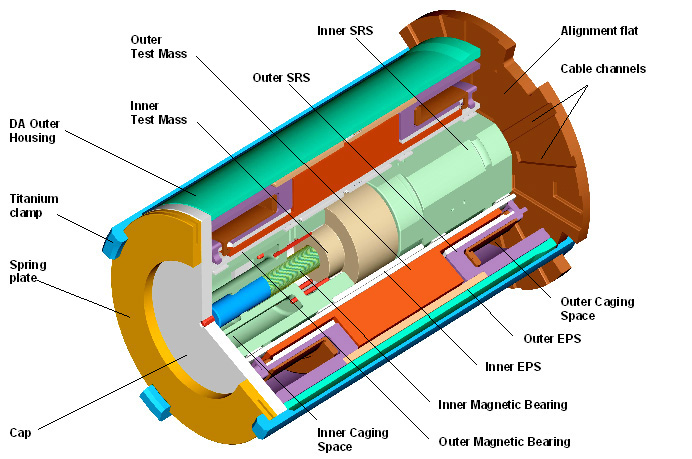
Testing Equivalence to One Part in 1018
The Satellite Test of the Equivalence Principle (STEP) will precisely measure the difference in the paths of eight test bodies as they orbit the Earth. To achieve the full potential of the experiment, we must pay careful attention not so much to measuring tiny accelerations, as to eliminating disturbances which could mask or imitate a violation of equivalence. Most of the experiment time is actually dedicated to identifying these disturbances rather than to making the measurement itself.
STEP's extraordinary sensitivity may be said to come from two factors. First, it uses nearly the full gravitational acceleration of the Earth, and the masses fall for a long time. The large gravity by itself would result in a signal about a thousand times larger than that in, say, Dicke's 1963 experiment, which used the much smaller acceleration towards the Sun. The increased time of fall over the few seconds possible in a drop tower gives an equally large factor. Second, STEP will operate in the extremely quiet environment of a drag-free spacecraft, which protects the test masses from the largest outside disturbances to their orbit without adding many disturbances of its own. This will more than one thousand times quieter than any place on Earth, because there are few disturbances in space and those which exist will be compensated by the drag-free control. The total gain, after taking into account the size of the remaining disturbances, is about a factor of ten million over Dicke, giving an expected sensitivity of one part in 1018.
|
|
Concept of STEP
Unlike a free fall from a tower, a free fall in orbit continues indefinitely. Any difference in acceleration (that is, any Equivalence Principle violation) can build up displacement for a long time--up to a few thousand seconds, because the direction of fall changes periodically. The buildup increases the signal relative to any noise, and the periodicity gives it a characteristic signal having frequency equal to the difference between the orbit rate and the rotation rate of the spacecraft. The amplitude of this signal is independent of spacecraft rotation rate, and the signal passes through zero when the sensitive direction of the accelerometer is horizontal.
In order to let the displacement build up to its maximum value, the test masses must be free to move at least until the direction of fall changes. The restraining forces along the sensitive direction will give the masses periods of 1000 seconds or greater. Conversely, the masses should be restrained from moving except along the sensitive direction, to avoid questions about cross coupling between directions of motion. This suggests that cylindrical geometry is natural for the apparatus. The STEP masses are constrained to move along a straight line by frictionless superconducting magnetic bearings.
A violation of 10-18 produces a motion of at most 10-11 meter in one orbit--much smaller than the diameter of an atom. To measure this tiny displacement, STEP uses position sensors based on SQUID magnetometers. These combine a measurement sensitivity of as little as 10-15 meter with the stability possible in a 2 K cryogenic environment using supercurrents. A combination of electric and magnetic fields will position the masses and allow us to make accurate measurements of some internal disturbances such as electrical charge on the masses or static background forces. The entire apparatus will be contained in an ultrahigh vacuum ( <<10-12 torr) inside a superconducting shield.

STEP Accelerometer Concept
The majority of disturbances can be eliminated by the design of the spacecraft and its systems. A simple example is regulating the temperature of the electronics packages used to run the experiment, to stop drift from thermal effects. It is a more complex problem to stop the gravitational interactions of the test masses with the spacecraft and environment. Partly, this is accomplished by centering the masses on each other. We measure the center of mass separation of two masses by the difference in acceleration that is caused by their being at different heights in the Earth's gravity, and use this measurement to center them precisely. The rest is done by making the masses as spherical as possible and still have them remain cylinders. We have found two ways to do this, the "straight" and "belted" designs, which have separate advantages.
Simple tests such as rotating the spacecraft in different ways can identify those disturbances that are most similar to an Equivalence Principle violation. The size of a violation does not depend on the frequency of rotation and it is always directed toward or away from the Earth. Outside disturbances, such as the impact of particle radiation from the Van Allen belts, do not depend on the rotation at all. Most of these can be totally removed from the data during analysis, because they have known effects or occur at known times. The disturbances which might simulate a violation--some of which have unusual causes such as "tides" in the superfluid helium cryogen--will in general change in amplitude and direction when the spacecraft is rotated at different rates. This allows a clear separation of these effects from violations.
About unknown disturbances, nothing useful can be said, but there is a way to handle them. That is to have as complete a set of measurements as possible of the apparatus and its environment. The limit to the experiment will then be set by the limit of our understanding the ways in which environmental factors disturb the measurement.
|
|
GP-B |
|